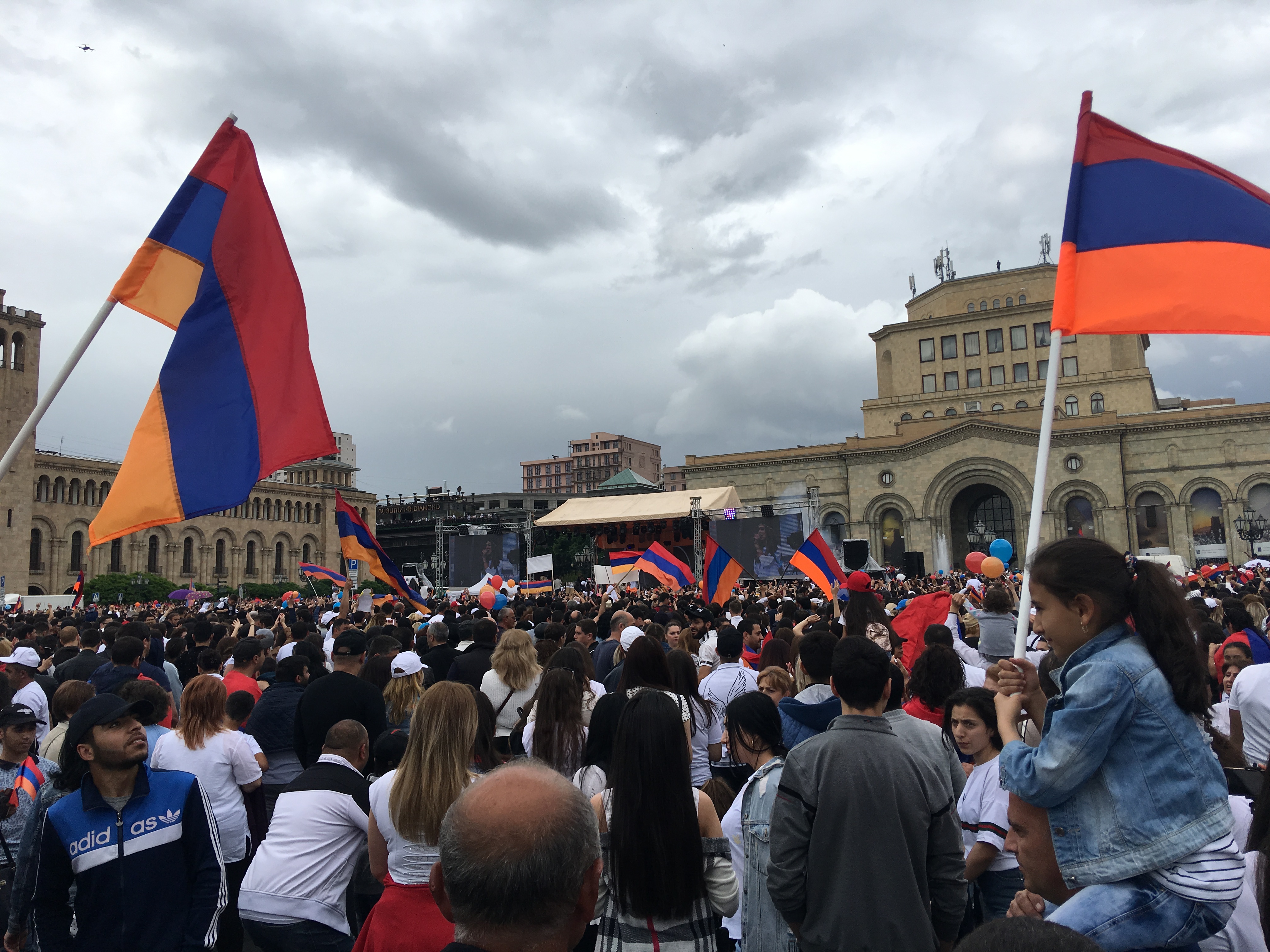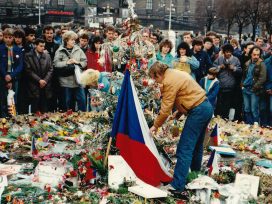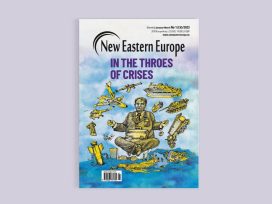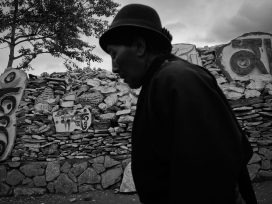‘1989’ can be understood as shorthand for both an agenda for ongoing research into how and why that year’s events happened in the manner they did, as well as a set of historical lessons and legacies for the organization of social movements and activism, particularly in opposition to authoritarian regimes.
When we say that dissent has an ‘agenda’ and a ‘legacy’, we mean two distinct things. ‘Agenda’ suggests applicability going forward, whereas ‘legacy’ suggests a revisiting of the past – not only looking the past as past (how we viewed it then) but, just as importantly, how we have changed our narratives of the past through the lens of the present. Some of the themes presented here suggest relevance and applicability not only to eastern Europe but invite us all to think about the ‘gift’ of democratic dissent for global civil society as well as other transnational contexts.
The legacies of 1989 are manifold, and have been much discussed, often in journals and books published on anniversary years. These legacies include the very idea of revolutionary yet non-violent change – what Adam Michnik called ‘new evolutionism’ and János Kis termed ‘radical reformism’. The very production of samizdat or unofficial publishing, private theatrical performances, underground university courses, legal defence efforts, and many other activities large and small, made possible the self-organization of society as described in Poland by Jacek Kuroń or the ‘parallel polis’ as dubbed by Václav Benda in Czechoslovakia. Activism was undergirded by theorization about non-violence and the creation and reinvigoration of an independent, self-organized civil society. Dissident writing and reflection at the time indicated regime change was not uppermost in mind: few sensed that, by engaging in the production of samizdat, or becoming involved in the democratic opposition in Hungary, Charter 77 in Czechoslovakia, or Solidarność in Poland, their actions would somehow lead to the scope and speed of change in 1989 – hence the annus mirabilus triumphalist end of the Cold War narrative.
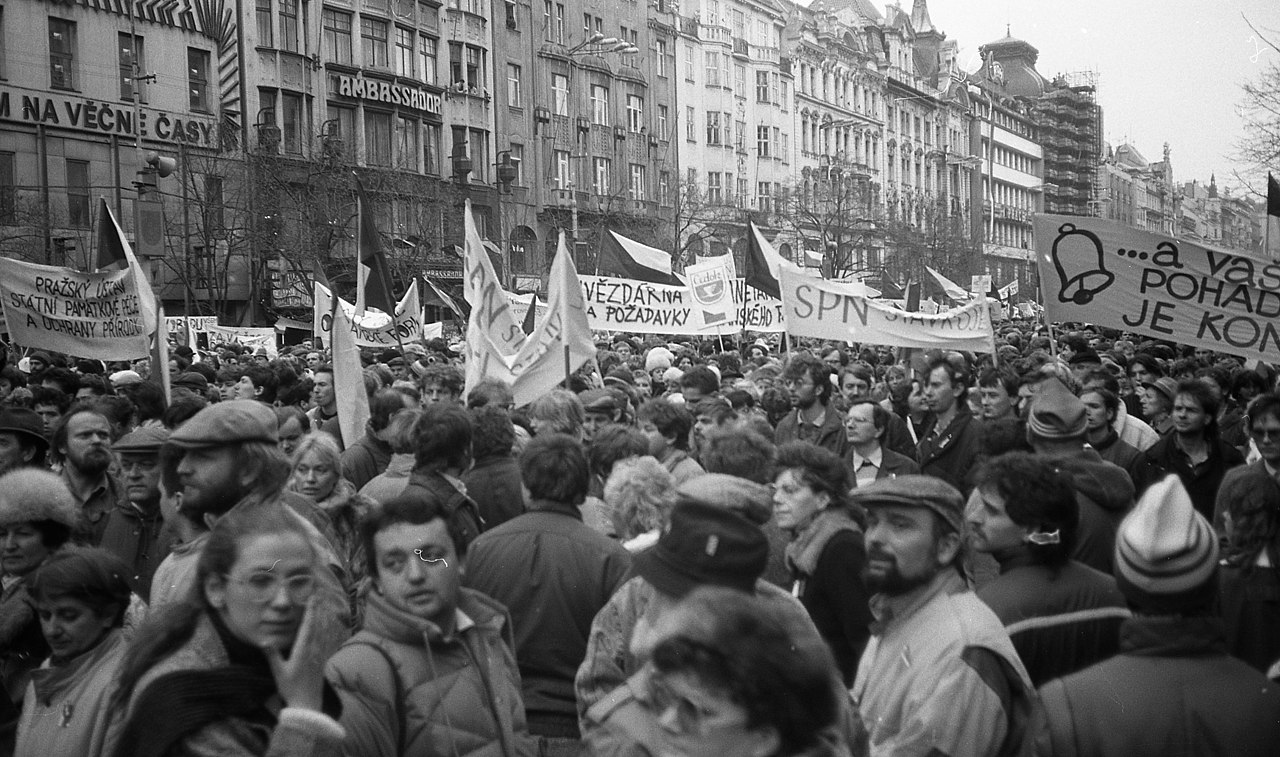
Street photo from the “Velvet revolution” in Prague 1989
Photo by Josef Šrámek ml. from Wikimedia Commons
This piece examines three examples or vignettes which suggest both agendas for further research and potential for activism, but crucially also considers the legacies of 1989 and their ongoing relevance in other contexts. First, the legacies of 1989 are relevant to the region from which they originally arose, that is, east-central and eastern Europe. Research on ‘dissidence’ writ large, including but not limited to civil society activism and resistance to authoritarianism, allows for further interrogation and analysis of the decades before and leading up to 1989. 1989 also provides a lens through which to view contemporary regional responses to the increasingly authoritarian and illiberal tendencies in Poland and Hungary, the 2019 summer of protest in the Czech Republic, as well as Slovakia, where there has been, arguably, a reversal of real and potential illiberalism and corruption, popularly signified by the election of Zuzana Čaputová as president.
Second, 1989 as a set of legacies allows us to ‘travel’ to other contexts where 1989 has been a precursor, a model, or an alternative example, and here I will analyse how 1989 reverberated in Egypt (or did not) in 2011 during the ‘Arab Spring’ and the ‘Velvet Revolution Redux’ in Armenia in 2018.
Third, and finally, 1989 provides a set of legacies relevant to addressing democratic deficits and reinvigorating civil societies across the West. This is particularly the case now, when all manner of ‘hybrid threats’, both from skilled adversaries externally, and divisive illiberals and populists internally, continue to assault democracies from without and within.
Before further analysis, however, a brief elaboration on the meaning of dissent is in order. Resistance as a broader continuum can be understood in an ecumenical sense, to include a ‘grey zone’ between outright regime support and direct opposition. Dissent is a more distinct subcategory of resistance, and is both political (or ‘anti-political’ to use 1980s parlance) and, at least to some degree, public. Importantly, resistance and dissent are part of a continuum that is fluid and flexible, not static. Looking at the global relevance of 1989 implies we need dissent today, so that is both a premise and an assumption. Dissent requires either operating within or creating space for civil society. Because there are risks involved, it means developing shared norms, what Charles Taylor calls ‘strong evaluations’ based on shared moral ideas or principles. The incubation of social trust is necessary, perhaps through friendship and discussion, and the building of mutually-held confidence that cannot be reduced to economic or social media transactionalism.
Context/Legacy #1: East-central Europe today
It is perhaps glaringly obvious to suggest the liberal – meaning politically liberal – and teleological narrative of 1989 has not turned out as planned. Viktor Orbán, Jarosław Kaczyński, Andrej Babiš – these are the political leaders and progenitors of ‘illiberal democracy’, and they have many counterparts elsewhere, not the least of whom are Vladimir Putin and Donald Trump. Moreover, efforts to disrupt or depose illiberal populism have not been going well, and one reason may be because we are reading from the ‘wrong script’ of 1989.
Orbán remains firmly entrenched in power in Hungary; to some degree the EU was focused to a much greater degree on the Euro crisis and Greek political and economic instability from 2009, while much of his personal power, and that of the governing party Fidesz, was concentrated via media regulation and curbing the independence of the judiciary. The sizeable protests and international response against ‘Lex CEU’ have failed, with the only practical response being the relocation of Central European University to Vienna.
If you Google ‘protests in Poland’ you get several Wikipedia pages, cross-referencing other pages on ‘riots and civil disorder’ and ‘rebellions in Poland’ – the upshot being that most of what is discussed happens between the late 1790s-1989. That is a trite measure, but much of the social mobilization in a country famous for it is acting in rearguard fashion against extremism that has been breathing new oxygen in recent years given illiberal space and social license – actions that are homophobic, xenophobic, antisemitic, and anti-EU.
‘A Million Moments for Democracy’ in the Czech Republic had a very successful summer in 2019, organizing large and weekly demonstrations. Yet, within Czechia, Babiš is unindicted for corruption, yet one hopes his government is slightly more wary of the Hungarian-Polish path of illiberality. If one is committed to some form of liberal democratic politics, the happiest news in the region comes from Slovakia, where the waves of protest following the murder of journalist Ján Kuciak also brought to power Zuzana Čaputová as president, on a progressive, pro-environment, pro-European, anti-corruption platform.
This vignette is very tricky, as it suggests a particular kind of legacy of 1989 – that of its ending via a ‘Velvet’ or peaceful and non-violent revolution. The velvety nature of the narrative has an almost fairy-tale-like quality: the people gather by the hundreds of thousands in city squares, chant some variation of ‘the Emperor has no clothes!’, engage in symbolically powerful and telegenic actions, and authoritarian rulers are forced to step aside in favour of people power. But we know that 1989 has also been reimagined in both positive and negative ways, often misconstrued and misunderstood. Originally, much of what happened in 1989 was what we wanted to see as liberal and progressive, a return to Europe, where mass mobilization reminded us of the value (and at least in Czechoslovakia, the memory) of democracy. Thus democratization, liberalization, marketization, and Europeanization were seen as the historically inevitable result of the fall of communism. Much of the writing on 1989 privileged liberal interpretations – the revolutions as intrinsically liberal efforts with nothing new to procedurally or theoretically to add to the canon of liberalism – or as tinged with optimism and Cold War triumphalism.
‘1989’ is now up for debate again, given the thirtieth anniversary of the annus mirabilis. But memory politics have engaged in some clever recasting, with ‘late communism’ as ‘totalitarianism’, ‘post-communism’ as the return to the nation, and independence and reclaimed sovereignty as a virulent rejection of the Other as dangerous and predatory (hence reactions to the ongoing migration crisis). Even the Holocaust has been appropriated to service the political needs of the present.
Understandably, there has been a populist backlash to the neoliberal reform programs of privatization and marketization that were accompanied with no small amount of corruption and enrichment on the part of the previous nomenklatura and the creation of a class of crass nouveaux riches – in societies attuned to both egalitarian values (four decades of communist ideology had some effect) and social apathy.
Aside from the teleology and blinkered optimism of the liberal reading, there have been two other kinds of misreading, especially regarding assumptions about both spontaneity and speed, and liberalism as a narrow form of economic neoliberalism. Reducing ‘1989’ to mass mobilization in the late autumn ignores both specificity and context: decades-long processes of resistance and dissent, initial failures in social movements’ strategies and tactics, and regime-level reform failures and regime-level negotiation, often a sense of helplessness, and eventually learned lessons. Failure and theorization (often in the ‘educational’ setting of a prison) yielded better tactics but no small amount of good timing, including the ‘Gorbachev Factor’ and the Soviet willingness to retreat, which made what occurred viable from the outset.
In reality, nothing happened quickly, and nothing was truly spontaneous. One important reason for this misunderstanding is that it was reinforced by one of the most well-known popular (and liberal) accounts of 1989, written by Timothy Garton Ash and published a year later.
In We the People, he reports telling Havel ‘in the back-room of his favorite pub’ that ‘In Poland it took ten years, in Hungary ten months, in East Germany ten weeks: perhaps in Czechoslovakia it will take ten days!’ He added nuance at the end of his account, but the ‘magic’ and speed of Czechoslovakia’s Velvet Revolution in particular, and 1989 in general, was baked into the narrative:
And if one asks, ‘Why did the revolution go so fast in Czechoslovakia’ then the simple answer is ‘because Czechs came last.’ East Germany was the final straw: seen, remember, not just on television but also in Prague itself, as the East German escapees flooded into the West German embassy. National pride was aroused. Rapid change was clearly possible and allowed, even encouraged, by Gorbachev. Everyone was ready. From the audience in the Realistic Theatre on the first Saturday who immediately leapt to their feet in a standing ovation at the actors’ demand for a general strike, to the crowds on Wenceslas Square chanting ‘Now’s the time’, from the journalists who at once started reporting truthfully to the workers who never hesitated about going on strike: everyone was ready. Everyone knew, from their neighbours’ experience, that it could be done.
As Padraic Kenney stated in his account of the ‘carnivalesque’ aspects of 1989, Garton Ash’s whimsical quip about ten days caught on like wildfire.But writing just over a decade afterward, Kenney also noted that Garton Ash’s oft-quoted remark conflated ‘revolution in the sense of civic mobilization, which had been going on in Czechoslovakia for over two years, and revolution as political settlement’. Kenney’s transnational research on the broader category of the ‘fourth wave’ of democratizing revolutions in the 1980s-90s tell us that such events were ‘deliberate and explicable’, far more planned than magical. 1989 needs to be situated within this context, and not seen as either regional exceptionalism or the inevitable and teleological result of Cold War triumphalism and the successful march of liberalism.
Finally, political liberalism has been too often conflated with economic neoliberalism, and post-communist trajectories gave a bad name to the former while allowing relative free rein to the latter. Austerity programmes and privatization schemes that benefited powerful oligarchies, such as the ‘loans for shares’ scheme in Russia, generated new forms of social destabilization and inequality. Governments themselves have been marketized, but in the absence of the rule of law and, most concretely, enforceable conflict-of-interest legislation, post-communism generated a series of pathologies resulting in the ‘rough justice’ described by Aviezer Tucker.
Unfortunately, the global moment in which 1989 happened coincided with the ascendancy of the ‘Washington consensus’ and elite support for neoliberal dictates. Yet the scope of what Claus Offe called the ‘triple transition’ – simultaneous systemic change in political and economic institutions as well as national and societal cultures – meant dramatic change would result.
There were going to be winners and losers regardless, and the rapidity of developments after (and not before or during) 1989 heightened opportunity and incentive structures for corruption, asset-stripping, the concentration of capital or its export abroad. Reading 1989 as ushering in neoliberalism does a disservice to the liberal project as a whole and ignores the importance of liberalism to democratic process.
Context/Legacy #2: Traveling from 1989 to Egypt in 2011 and to Armenia in 2018
In April 2012 in Cairo, Czech Ambassador Pavel Kafka and the Czech-Egyptian Friendship Association sponsored a reception launching three Czech texts translated into Arabic, one of which was Václav Havel’s ‘The Power of the Powerless’. Foreign Minister Karel Schwarzenberg stated: ‘We thought the main work was done when the revolution was complete, but we have actually only just started’ – prescient given the installation of military rule in Egypt in 2014. He later compared the Arab Spring in Egypt to the Prague’s Velvet Revolution, as ‘both were,’ he said, ‘fighting for freedom and for the rule of law – against oppression, and therefore lessons should be learned’.
Before Paul Wilson’s last conversation with Havel before he died, in March 2011, he asked Havel permission to arrange for Arabic translation of ‘The Power of the Powerless’ – which was granted. Wilson himself was en-route to Cairo to witness the potential echoes of 1989 in the Arab Spring. In an Al Jazeera interview, Wilson recalled that Havel asked him if the Egyptians were ready for democracy. Wilson retorted, ‘Were you ready in 1989?’ Khalid Biltagi, the translator, thought the essay might be influential, hopeful that a similar peaceful revolution might occur in Egypt.
As events unfolded in the winter and spring of 2011, political pundits and commentators discussed the Velvet Revolution, but even with this very different geopolitical context, Western intellectuals tended to see what they wanted to see in the Arab Spring. Alain Badiou noted the‘fighting, barricading, debating, camping, and cooking, and caring for the wounded constituted the “communism of movement”’. Slavoj Žižek said the lack of hegemony, leadership, or apparatuses constituted the ‘miracle of Tahrir’. Finally, Michael Hardt and Antonio Negri, suggested there was, along with the Occupy protests later the same year, a longing for ‘real democracy’.
Was the Velvet Revolution or 1989 actually referenced during the Arab Spring? Not according to Asef Bayat, with whom I had an email exchange on this very point. It was, of course, referenced – by us.
There were, however, meetings with Otpor and the April 6 Movement in Egypt, prior to the outbreak of 2011. However, in the handbook and training approach adopted first by Otpor and later by the Center for Applied Non-Violent Movements (CANVAS), the consultancy created by two of Otpor’s founders, the resonances of 1989 persist, albeit in distilled form.
Moreover, Bayat’s discussion of spontaneous social mobilization and Durkheimian collective effervescence in Egypt echoes James Krapfl’s account of the Velvet Revolution in Czechoslovakia, and his description of the ‘carnival of conviviality’ is reminiscent of Padraic Kenney’s analysis, drawing from Bakhtin.
But there are many obvious differences, such as the constellation of state-society relations, the degree of relative poverty in Egypt, a large youth bulge, and fractious minorities and religious groups (some charged, rightly and wrongly, with violent extremism). Egypt has long been ‘conditioned’ by neoliberalism and has historically been a prime recipient of US military aid. Unfortunately, in Tahrir there was a paucity of credible leaders, no lasting or pre-existing umbrella-type or coalition of social movements. As to whether or not the new normal is much like the old normal, Bayat states:
things will often appear to have gone back to normal as people carry on with their mundane routines – working, shopping, visiting friends, or going on vacations. Those who expect rupture and resistance would no doubt be dispirited by such brutal inertia of the everyday. But one should not be deceived or disheartened by the seeming normalcy, for in substance it may not necessarily be a measure of popular consent or compliance. Rather, it could be driven by the inner force of life itself, expressed in an urge for self-regulation; it could further serve as a technique of survival in rough times, the old-fashioned art of creating one’s own reality in the shadow of authoritarian rule, as if the populace is in compliance and the regime is in control.
Bayat’s description is eerily reminiscent of Havel’s writing in the 1970s, or Milan Šimečka’s critique of normalization-era Czechoslovakia. In many respects 2011 is the reverse of 1989; the former digital, the latter analog, 2011 was the beginning of a process of change, 1989 the culmination of a process of change. But, as we move forward from and look backward to both 1989 and 2011, we will be re-reading and re-narrating those pasts in the light of dissimilar presents. What looked like a moment of shining similarity, comparing Wenceslas Square to Tahrir Square, may be little more than a distortion when we refocus to look at differences in light of subsequent political and social trajectories.
One of the most astute observers of recent digitally-networked protests and social movements, from Zucotti Park to Tahrir Square, Zeynep Tufekci, describes the ‘affordances’ or structural advantages of a digitally-networked public sphere for social movements. Organizing via social media allows the bridging of weak social ties, speed and reactive capacity, and rapid responses to logistical and marketing challenges.
However, rapidly organized protest via social media contains many shortcomings, too. Speed and connectivity mean missing out on ‘network internalities’ – what Tufekci calls ‘resilience’, decision-making, a movement’s capacity building, long-term organization, negotiation of tactics and strategy, and the development of lasting structures. The resulting ‘adhocracy’ means protests happen before movement building. The combination of leaderlessness, speed, and adhocracy contribute to ‘tactical freeze’: the inability to adapt to new or changing conditions, or to act as effective interlocuters with the regime. Moreover, as Tufekci points out, having no legitimate leaders, or even eschewing traditional hierarchies, does not mean true leaderlessness, as Jo Freeman wrote in ‘The Tyranny of Structurelessness’.
Without obvious interlocuters, an authoritarian regime can more easily construct ‘protesters’ as an undisciplined and amorphous mob. On social media, disagreements are preserved and extended for all to see. There is no backroom negotiation. There is no possibility of a Marian Čalfa-Vacláv Havel side deal or a Polish or Hungarian roundtable negotiation process, which has other downstream disadvantages, notably conspiracy theory about the ‘fixed’ nature of the change. Her critique of Egypt in 2011 also applies to the Occupy movement, Gezi Park in Turkey, and the ‘Umbrella Revolution’ in Hong Kong.
If I am skeptical of Egypt as an example of the legacies of 1989 meaningfully traveling, I am more hopeful about Armenia. Indeed, I would argue that in Armenia you have something not akin to the recipe-based ‘colour revolutions’ so influenced by Otpor and more limited in aims and focus, and in that respect more like 1989 as it unfolded, and not via the triumphalist lens through we which tended to view it later.
Under the leadership of Nikol Pashinyan, what started as a march throughout Armenia to demand the resignation (rather than the extension of the rule of) Prime Minister Serzh Sargsyan became, over a course of forty days, a self-branded ‘Velvet Revolution’. The protests were largely led by the ‘Independence Generation’ in Armenia – those born after 1991, and particularly those employed in the country’s relatively oligarch-free technology sector. Pashinyan was already a leader, a member of the Armenian parliament and head of a political party, who had gone ‘mainstream’ after the failure of protests following a presidential election resulted in violence in 2008.
The 2018 protests began with general and specific grievances, including high unemployment, endemic poverty, emigration, and the embezzlement of military funds (important given the ineffective and nepotistic rule of Sargsyan’s Republican Party). Unlike in Egypt, there was no ‘tactical freeze’. There was significant in-group social trust, knowledge, and previous experience in the inner circle around Pashinyan, who had sorted out the network internality challenges highlighted by Tufekci. They were also connected via the ‘strong moral evaluations’ described by Charles Taylor, not the weak social ties offered by online platforms. During the protests, Pashinyan was also an unwavering and effective leader with a strategic, well-defined vision.
As smaller protests swelled to more than 500,000 demonstrators occupying much of central Yerevan, demands focused more concretely on the immediate resignation of Sargsyan and ending corruption in domestic politics, including electoral vote-rigging. The revolution was not about a ‘return to Europe’, joining NATO, or anything at all do with the West, and was neither a direct nor indirect challenge to Putin or Russian regional hegemony, which may provide insight into why it did not invite Russian ire or intervention. This effort was about Armenians improving governance for Armenians.
As with east-central Europe in the 1970s and 1980s, there was a sense of learning from previous mistakes – not only from 2008, but also the 1990s and the Karabakh movement of the 1980s.
As with 1989, there were many carnivalesque moments and happenings, and shared cultural touchstones formed a bedrock. Both Pashinyan and Garin Hovannisian, who made a documentary as events were unfolding, emphasize the poem, later a song, that became the movement’s anthem. Pashinyan and his small cadre of coorganizers were tactically smart, highly improvisational, and changed when circumstances demanded. For example, they went from centralized protests (the occupation of Republic Square) to decentralized and disaggregated events (stropping traffic and public transit throughout Yerevan).
Literally, a reserve army of women stepped up when men were arrested (using the regime’s gendering to their advantage), initiating protest in private spaces that had very public repercussions. By disobeying a noise ban with pots and ladles, home-based protestors erased the public/private divide and delegitimized the authorities by showing the depth of support for Pashinyan. We have seen this before: under authoritarian communism (and other forms of authoritarianism), there is a prescribed but ersatz public sphere, alongside which grows a more authentic public sphere, often cultivated in and protected by private spaces (a ‘parallel polis’, as Benda put it).
Finally, in Armenia there was a willingness to bend among authoritarians, and a Prime Minister who was ready to resign when the pressure mounted. This is critical: the regime was not just prepared to negotiate, they did not respond to mass protest with arrests, detentions, and violence.
Authoritarian ‘learning’ often goes in either direction. In China, the lesson of Tiananmen was that violence worked, though, in the succeeding years, this depended on an implicit social contract where political quiescence was exchanged for economic upward mobility. This was also the case in Iran in 2009. In Egypt and, earlier, in Algeria, the justification for authoritarianism had been that popular mobilization leads to a dangerous politicization of religion. The lesson of Tunisia, and perhaps more recent Algerian developments, is that religious parties can be incorporated into mainstream politics, but only with a strong civil society determined to prevent rollback.
However, in Armenia, the moment Sargsyan invoked past violence on television in conversation with Pashinyan, implicitly threatening another March 1 2008, he heightened his illegitimacy and emboldened the movement. Pashinyan sensed this and did not yield. The movement had ballooned, attracting students and close supporters of Pashinyan at first, but later also professionals, workers across many sectors of the economy, and then, crucially, the clergy and members of the military.
Reminiscent of the work of Guillermo O’Donnell and Philippe Schmitter on earlier transitions from authoritarian rule, there were both dictaduras (a dictatorship with single-party rule, intolerant of pluralism) and dictablandas (a dictatorship that claims to preserve and not erode civil liberties) in Armenia, and it was critical to know with whom negotiation was possible, not just at the government level but in terms of police and security forces.
Pashinyan offered the Chief of Police his job again after taking power, but only on the condition that he could do his job ‘without getting rich’ – that is, by not tolerating or accepting a culture of bribery or corruption. He agreed. The lesson here is that regime defectors are important. There is even a certain heroism in retreat or in serving newer, legitimate political masters and agreeing to be bound by the rule of law. This is also a lesson of 1989.
Still, Armenia also reminds us that, despite the urge to compare, draw lessons, and make recommendations, each case is also sui generis, specific, and contingent upon local facts and consequences. In Armenia, timing turned out to be critical, because demands for Sargsyan’s resignation and the regime’s implied threat of violence happened literally the day before the anniversary of the Armenian genocide. The idea of an Armenian leader potentially responding to a largely peaceful gathering of Armenians on April 24 with violence was anathema to all elements of society. Thus, Sargsyan resigned on April 23. The struggle for genocide recognition, the constant and transnational battle against genocide denialism, unites all Armenians. This is not a situation that could be replicated anywhere else, providing a further caution against appropriating 1989 as a recipe-based approach to regime change from below.
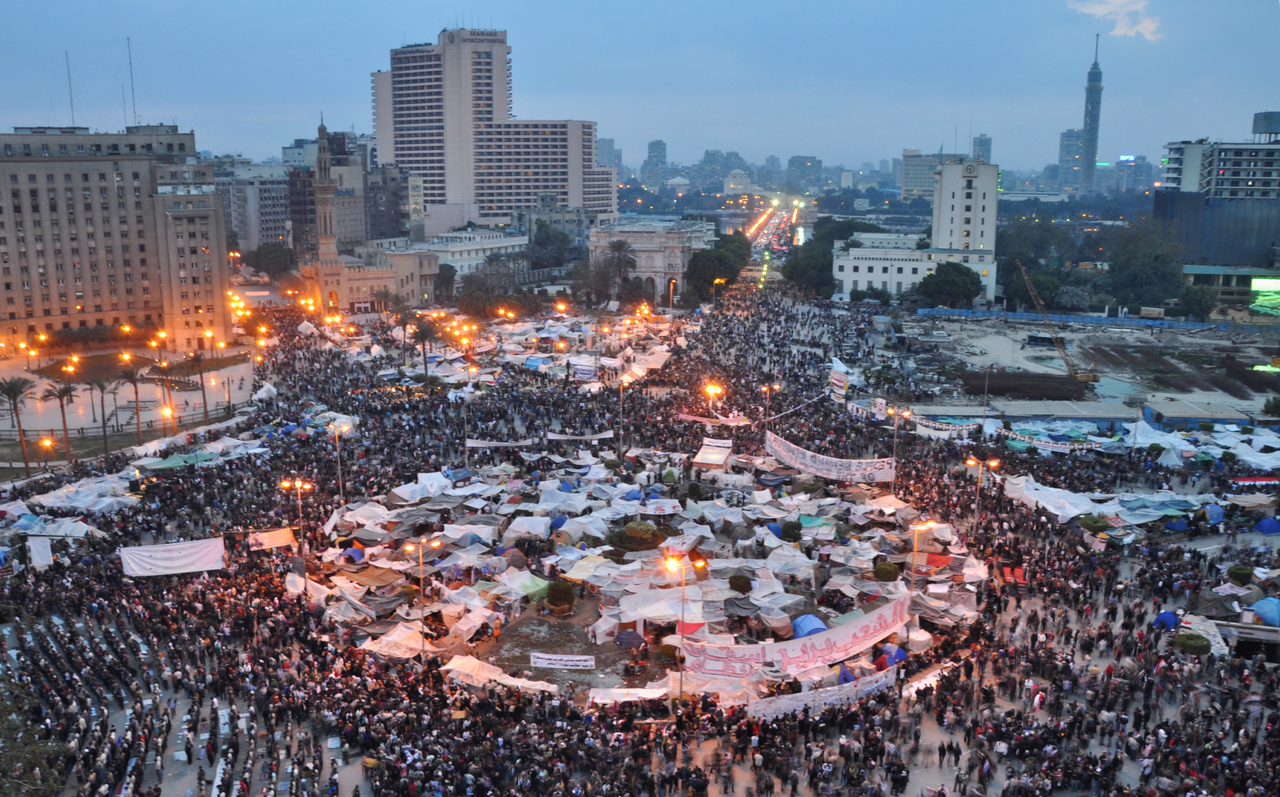
Over 1 Million in Tahrir Square demanding the removal of the regime and for Mubarak to step down.
Photo by Jonathan Rashad from Wikimedia Commons
Context/Legacy #3: Western ‘consolidated’ democracies
I will, finally, suggest legacies of dissent and 1989 are relevant to contemporary discussions of ‘hybrid warfare’ and the ‘grey zone’ disruption strategies of antidemocratic and illiberal adversaries.
Inconveniently, a great deal of what has happened globally since 1989 has disrupted the triumphalist 1989 narrative. There has been a surge in neoliberal corporate globalization, aided by domestic deregulation, the development of global supply chains in the production of goods and services, and an increased delinking of capital from state boundaries. At the same time, relative global inequality has risen even while absolute poverty has decreased. 9/11 ushered in a series of overseas operations, a ‘forever’ war styled as the global ‘war on terror’, more concretely targeting various violent states (Afghanistan, Iraq, Libya) and sub-state violent actors (Al Qaeda, ISIS). Other ongoing intractable conflicts (from Central America to Congo) have Cold War antecedents, while the climate crisis looms as a game-changer in terms of global and domestic politics and economics.
Mixed flow migration has increased due to all of the above as well as the ‘oldest’ reason for migration: seeking a better life for one’s family and children. Following the impact of the twenty-four hour news cycle in the 1990s, we are subject to the simultaneous fragmentation and concentration of the media, the rapid impact of new communications technologies, and algorithms that generate echo chambers and social polarization. The structural barriers to global interpersonal communication have both decreased and increased, eroding our sense of shared reality, facts, or truth. One result has been the ‘politics of fear’ and the manipulation of anxiety, anger, and insecurity, all used to justify extra-constitutional or extra-judicial measures – the ‘states of exception’ described by Giorgio Agamben – and the need for ‘third-party enforcers’. That is, not just the ‘old’ enforcers, such as the police and military bounded by law, in short supply, and subject to democratic control and caveat, but private security, whether in gated communities, prisons, or operating as proxies for states, non-state actors, or in accordance with their own logics of profit, market-share, adrenalin, and status. This is the situation Zygmunt Bauman called ‘liquid modernity’, what Karl Marx presciently if prematurely pronounced as one where ‘all that is solid melts into air’, a society that Hannah Arendt described as one where ‘everything was possible, and nothing is true’.
Cynicism, cleverness, the casual cruelty of social media, militarized masculinities, and the brutality of war and the traumas inherited by both individual soldiers and societies at large – all this provides fertile ground for the normalization of social license granted to online and real world varieties of racism, sexism, homo- and transphobia, xenophobia, and identitarian toxicity. What one might call ‘postmodern populism’ becomes a set of tactics, empty of coherent ideology, functioning as a flexible container to be channeled by a charismatic leader. But what do the legacies of 1989 have to do with any of this? Narrow and triumphalist 1989 narratives are implicated, but perhaps alternative readings of 1989 open up other possibilities.
One triumphalist reading of 1989 blithely equated political freedom with free markets, providing ideological gloss and respectability to neoliberalism. A free-market ethos without constraint was the approved game of the 1990s, but has yielded governments in eastern Europe that, while definitely profit-driven and market-oriented, popular with their citizens, and easily electable through mass market disinformation and functional control over key media, are increasingly without the institutional, legislative, and constitutional constraints that keep democracies politically liberal in form and substance. Russia and Hungary are but two examples; Poland is perhaps more populist than illiberal and has a deeper tradition of civil society pushback.
Another reading of 1989, based on the idea of speed and simultaneity as a regime-change cocktail recipe, brought us from Berlin to Baghdad. ‘Old school’ dissidence, an elastic, contestable term with multiple meanings that need to be acknowledged if we are not to reify it, yielded a simplified version via Gene Sharp, Otpor, the idea of ‘manufacturing’ or replicating colour revolutions, and a simplistic and ahistorical ‘transitology’ in academia. Some of this worked, for a time: Slobodan Milošević was overthrown, as was Hosni Mubarak in Egypt.
One major problem is that the tactics have bitten back, because authoritarian leaders have been learning these simplistic lessons of 1989 too. Srdja Popovic of Otpor fame wrote manuals later read by Russian, Belarusian, and Iranian security ministries. Authoritarian regimes with money and serious technology (China, for example) can build their own platforms of social connectivity which also offer opportunities for immense state surveillance. Less wealthy but innovative and illiberal authoritarian states (Russia, for example) have developed state-sponsored disinformation efforts involving layers of state involvement or plausible deniability: state-sponsored or state-directed trolling, franchised information war through ‘civil society’ groups (such as Nashi), and state-coordinated and state-incited campaigns. Lesser authoritarians of the developing world (say, Duterte of the Philippines) rely on what already exists and adapt the logic of free speech to undermine both political opponents and human rights through overabundance of information.
Old style censorship is quaint; samizdat is as old-fashioned as cursive writing. The brilliance of all of this is that authoritarians are learning the lessons of the Cold War, especially the thin triumphalist version of its ending, and going one better, producing the ‘2.0 version’. Then they sow a great deal of red herring moral equivalence into the mix as well. For every potential accusation of foul play by the West, there is a counternarrative in the name of ‘balance’ or simply contrariness. One is reminded of the tag line of Russia Today, Russia’s state-sponsored international and foreign language television network: ‘Question More’.
If there are accusations about election meddling through sowing disinformation and troll farms to polarize online discussion, then one could also assert that election meddling is a long-time American preoccupation, going back to the Italian elections of 1948. One might complain about the antisemitic accusations hurled against George Soros in Hungary and the interference purchased by ‘his’ Open Society or university, but counter with American money funneled to Solidarity in the 1980s, or earlier CIA funding to Radio Liberty and Radio Free Europe. At the United Nations, why support the US-backed resolutions to end the violence in Syria when we know intelligence was politically manipulated to support military intervention and regime change in Iraq, or how ‘mission creep’ in Libya yielded not an effort focused solely on the protection of civilians but more muscular regime change? The rooting out and killing of a dictator led to another descent into civil war.
This is how half-truths are baked into broader conspiracy theories, which Peter Pomerantsev suggests is the contemporary replacement for ideology, with a mix of ‘self-pity, paranoia, self-importance and entertainment’. This is fuel for illiberals and authoritarians alike: in place of coherent policies there is, on the one hand, depoliticization and cynicism, and, on the other, the elite manipulation of generalized fear and insecurity, unmoored from facts and evidence, promoting ‘strong’ leadership.
When in a situation of factual fluidity, the rejection of all authority, competing truth claims, and asymmetric, grey zone information operations combined with kinetic effects, you are in a new form of conflict: hybrid warfare. Hybrid warfare involves the weaponization of a very crude form of postmodernism, and speed, simultaneity, and social media are not the answer.
Countering these destabilized realities, I want to think about a different set of legacies of 1989 and their relevance for today for democracies the world over, as well as for non-democratic or illiberally democratic contexts. By legacies I mean less the actual politics or programmes of dissent, but instead the longer social processes involved rather than the short-term tactics of social mobilization. Because, as Tufekci’s work comparing the Arab Spring and Occupy movements with the American civil rights movement illustrates, when protests and politics happen before movement building, the result is horizontalism, leaderlessness, tactical freeze, no strategic vision and a resulting distrust of conventional politics and elites.
Jeffrey C. Isaac has focused on other meanings of 1989: anti-political politics built in genuine independent spaces of civil society, and the promise of participatory democracy. He suggests that the ‘repertoires of collective action enacted by anti-communist dissidents were of continuing relevance even under a liberal democratic regime’. Isaac reminds us that ‘the meaning of 1989 remains inherently plural, and contestable, and revisable in light of experience, and even from the vantage point of a liberal democratic appreciation for the accomplishments of 1989, it is both possible and necessary to rethink this appreciation’. Isaac was also careful to caution against all-encompassing narratives about celebration, triumph, oppression, or liberation.
To be sure, 1989 contains legitimate multiple meanings, not easily reducible to either facts or interpretations, because of the normative character of those narratives. Indeed, the normativity of those narratives and the lived experience of the participants is emphasized by James Krapfl’s work on Czechoslovakia. Krapfl distilled the ‘ideals of November’ in his cultural history, including and perhaps most importantly non-violence. There was a shared commitment to non-violence in East Germany, Poland, Hungary, and Czechoslovakia, and this had been much discussed, especially the oft-repeated exhortation of Adam Michnik, that those who storm Bastilles end up building new ones. Having experienced more than a century of failed rebellions against Russian and Soviet rule, including a massacre of workers in Gdańsk in 1970, arrests and imprisonments following the riots of 1976 and the imposition of martial law in 1981, non-violence was clearly the strategic choice in Poland. Given Krapfl’s research on the Velvet Revolution, and the centrality of non-violence as one of the preeminent ‘ideals of November’ it makes sense to think of non-violence as both a strategic and a moral choice in the Czechoslovak case. Krapfl explains that non-violence was deliberate, difficult to maintain, and that the revolution itself ‘was against not just physical violence but violence of all kinds, including psychological, social, economic, and ecological’.
One point requires reiteration: the glue that holds together civil society and social movement organization together is trust. Social media powerfully assist in moments of mass mobilization but can be turned on and against you. Adam Seligman defines trust as a ‘discrete form of human interaction and an ideal model of communal life’. Civil society, the space where we ‘dissent together’ depends on social trust. This includes Durkheimian solidarity, but also basic confidence in one another to keep our word and responsibly follow through on our commitments. Seligman suggests trust is a cognate of confidence, faith, and familiarity, and a very modern ‘emergent property of human interaction, tied to a very specific form of social organization’. Trust cannot be reduced to either rational choice or expanded in a generic way to some irreducible aspect of human morality or well-functioning collective conscience. He wrote presciently that the dissolution of trust leads to the risk that we lose the strong shared evaluations of each other and society – our very ability to communicate with similar meanings, reference points, base knowledge, and civility (the deliberative aspect of democracy so prized by Michael Sandel) – and that risk can be ‘transformed into problems of danger’.
For Seligman, trust is institutionalized in liberal societies through constitutional democracy via a necessary basket of civil rights to guarantee individual and political freedom, meaningful representation and participation in the public and political sphere, and finally minimum standards of social and economic welfare. Once one of them is unraveled, so are all of them; social trust is unmoored until it disintegrates into fear and the impossibility of social and political negotiation. We no longer inhabit the shared space that makes that possible. We rather exist in increasingly separate and hostile universes where our basest fears and insecurities are stoked and rewarded. Shared social identities come apart, replaced by primordial attachments to nation, hatred, or fear of the Other, protectionism, and clinging to a view of political, social, and economic life as an extreme zero-sum game. In short, the dangers identified by Seligman are the razor’s edge on which so many societies and states are currently teetering.
Seligman’s work on trust also demonstrate the relevance of societal resilience, within and through civil society, and may be one of the ways of dealing with illiberalism, creeping authoritarianism at home, and hybrid threats from our adversaries. If the parallel polis meant anything, it was a place to cultivate trust.
Adam Gopnik, in his recent defense of liberalism, A Thousand Small Sanities, discusses how, in the eighteenth century, trust grew in and along with the public sphere, as in coffee houses, where you could try out and explore new ideas and identities. At least some of the time, trust was built across earlier social cleavages of class, race, ethnicity, nation, and gender. The fact that you did so in person was, however, critical.
We need to look back and deeper into the interpersonal legacy of 1989’s anti-political politics: true, participatory democratic processes, engaged and activist civil society, small measures, creative repertoires of collective action, developed through time, trial and error, through friendship and trust. Of course, that cannot be replicated in a 2.0 manner, nor should it. While capitalism asset strips one kind of belonging (reducing us to shareholders or consumers, not stakeholders or citizens), nationalist politicians promote a pastiche of nostalgia, conspiracy, and responses to fluctuating grievances and truths based on misreadings of histories that never really existed.
Today it is difficult to recover, paraphrasing Hannah Arendt, the ‘lost treasure’ of 1989 because we know so much about what came later: privatization that benefited the former nomenklatura, inegalitarian immiseration resulting from neoliberal marketization, the initial price paid for European Union membership including the 30,000 plus pages of the acquis communautaire, the ongoing challenges for women and labour (two groups at least ideologically privileged under the old system), and more recently toxic partisanship, Euroscepticism, xenophobia, and Islamophobia. Yet it is exactly this ‘lost treasure’ that one associates with a positive, ongoing, and ‘actionable’ set of legacies from 1989. We need to recapture this Arendtian lost treasure in our scholarship and combat publicly misappropriations of 1989. The risks of not doing so are simply too high.
This article is adapted from a keynote address given to the workshop, ‘East European Dissent Between Agenda and Legacy’ held in Brussels, October 3-4, 2019. The author wishes to thank the organizers, and in particular Ferenc Laczo for his encouragement and indefatigable efforts and editorial assistance.


